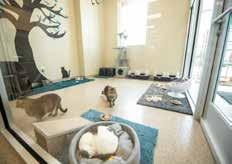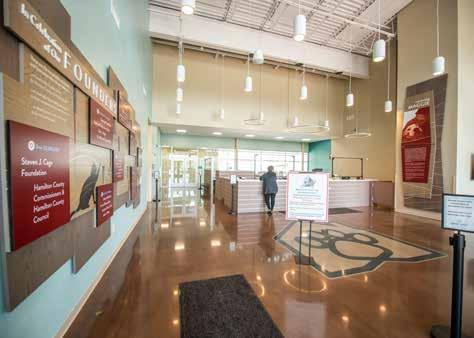
5 minute read
For the Pets: The Humane Society for Hamilton County Moves to a New, Bigger Facility
NORTHERN
MAGAZINE
FOR THE PETS
THE HUMANE SOCIETY FOR HAMILTON COUNTY MOVES TO A NEW, BIGGER FACILITY
Writer / Christy Heitger-Ewing Photographer / Amy Payne
The Humane Society for Hamilton County takes in more than 3,100 animals each year. Through their Survivor Program, they were able to provide second chances to 1,440 animals, 574 of whom were rescued from other Indiana shelters and non-Hamilton County residents.
“We accept animals, strays and owner surrenders 365 days a year as an openadmission shelter,” says Megan Davis, marketing communications manager with the Humane Society for Hamilton County.
In the past, the organization operated out of an 8,000-square-foot space that they shared with the Low Cost Spay Neuter Clinic. But on April 8, they officially moved into a massive new 40,000-square-foot facility in Fishers. The Humane Society for Hamilton County launched its Building a Brighter Future for Hamilton County & Hoosier Animals Capital Campaign in November 2018 raising the $12M needed to build the 40,000 square-foot facility in Fishers within one year, thanks to lead gifts from the Steven J. Cage Foundation, Samerian Foundation, the Hamilton County Commissioners & Council, and Dr. Mark and Vanessa Roth. The facility, which was designed by Curran Architecture with the construction managed by Meyer Najem, will bear the name of both the Humane Society for Hamilton County and The Steven J. Cage Foundation Animal Wellness Center.
In the new facility, they will expand from one cattery to four free-roaming cat rooms. Each of those rooms attach to two patios, so workers will be able to open a door to give felines fresh air and sunshine.




“That’s a huge enrichment piece for the cats to keep them in a good head space, while they wait for their forever home,” Davis says.
On the canine side, the outdoor space will increase significantly. Besides the outdoor runs, they will have an indoor exercise area, five indoor meet-and-greet areas, and 50 kennels (up from 15). Windows in all kennels will have a front and a back side, so if an animal has an accident, they don’t have to sit in it. They will also have three “gray muzzle” kennels, offering senior dogs a quiet, stress-free space.
“I have a soft spot in my heart for senior dogs,” Davis says. “They need extra love and space.”
All kennels and catteries are set up with individual, segmented HVAC systems, so if a kitty in one of the catteries gets an upper respiratory infection, staff can shut that cattery down, nurse them back to health, and keep the air from circulating through the other catteries.
“It’ll make our jobs easier when it comes to containment and treatment, but also keep the animals safer, and that’s our biggest goal,” Davis says.
An entire half of the building is dedicated to intake processes, medical attention, and isolation. The new location will also separate the admission center from the adoption center. “In our (former) building, there were times when someone is surrendering a pet and they have to be right next to someone who is going through an adoption,” Davis says. “Having that happy feeling next to that sad, upset feeling is a weird position to be in. We’ve separated the two aspects of what happens at our front desk to make that experience as painless as possible on the admissions side, and as happy as possible on the adoption side.”
The Humane Society is also expanding many of their community outreach initiatives by adding an education center that is set up with a projector, a white board, tables and chairs. Post-pandemic, they’ll be able to host birthday parties, scouting groups and school field trips. Davis says it’s not uncommon for adoptions to rise after an educational experience.
“We’ve taken an animal into a classroom and had kids go home and tell their parents that they met a puppy, and that they’d like to get one,” Davis says. “The next day, the parents are here.”
But it’s not just about adoptions. The outreach component is centered around teaching children about bite prevention, responsible pet ownership, and proper ways to treat an animal.
“It’s also about teaching them about serving their community, and when they’re old enough, they can volunteer, foster and donate,” says Davis, noting that she’s often seen children fundraise for animals or donate their birthday money to the Humane Society.
Pets Healing Vets is a program that pairs Hoosier veterans suffering from PTSD or traumatic brain injury with shelter animals.
“We truly believe in the healing power of pets,” Davis says.
Unfortunately, cost is often a large barrier to veterans adopting a dog or cat.
“We wanted to be able to give those veterans a chance to heal with an animal that can become an emotional support as well as a family member, so we pay for all of the pet’s care for the life of the pet,” Davis says.
It’s rough when an animal comes into the Humane Society either injured, malnourished, mistreated or ill. Watching them persevere and work with staff to get better, and eventually adopted into a perfect home, is what makes Davis and her team cry happy tears. Thankfully, there are many success stories. Take Taylor, a pocket pit bull who came to the Humane Society as a puppy with a chronic cold. She kept coming down with pneumonia and getting hospitalized, but after seeing a specialist, they learned she had a severe case of doggie asthma and needed to be treated with a nebulizer twice per day.
“No one wanted to adopt her because of her condition, so she sat here for more than a year, but then it happened - the thing I’ve seen happen many times,” Davis says. “Someone walked in the door, pointed to Taylor and said, ‘That’s my dog. She’s the one I want.’”
Taylor’s now living her best life and enjoying what it feels like to live in a home with a loving family.
“That is what it’s all about,” Davis says.
The new address for the Humane Society for Hamilton County will be 10501 Hague Road in Fishers. For more information, visit hamiltonhumane.com. To make a donation, visit Brighterfuturewishlist.com.










